Soviet Venus Research and Development Program
Very often on the Internet you can find materials that relate to the Soviet program of development or even the colonization of Venus. It should be noted that such programs have never been seriously considered, accepted or implemented in practice. At the same time, near-scientific articles and materials that dealt with the development of Venus and the possibility of its use by man really appeared. Today on the official website of the Roscosmos television studio you can find an interview with the design engineer Sergey Krasnoselsky, which tells about the projects for the development of Venus. This question has always interested scientists, engineers, designers and just people who are interested in space, but from a theoretical point of view. The practical side of the Soviet space program was focused on the study of Venus. And in this issue the USSR has achieved outstanding success. The number and scale of the research conducted and the satellites and space stations sent to Venus led to the fact that in the world of astronautics, Venus began to be called the “Russian Planet”.
What do we know about Venus
Venus is the third brightest object in the earth’s sky after the Sun and Moon, and you can watch the planet in good weather without a telescope. In its brilliance, the closest planet to the Earth of the Solar System is significantly superior to even the brightest stars, and Venus can also be easily distinguished from the stars by their even white color. Because of its location relative to the sun, Venus can be observed from Earth either some time after sunset, or before sunrise, therefore, in the culture, two bright definitions for the planet were fixed: “evening star” and “morning star”.
Observation of Venus is available to the average man in the street, but scientists, of course, are not attracted to this. Being the closest planet to Earth (the distance to Venus at different times ranges from 38 to 261 million kilometers, for comparison, the distance to Mars is from 55,76 to 401 million kilometers), Venus also belongs to the planets of the Earth group, along with Mercury and Mars. Venus was not accidentally called the “sister of the Earth”, in its size and mass: the mass is 0,815 terrestrial, the volume is 0,857 terrestrial it is very close to our home planet.
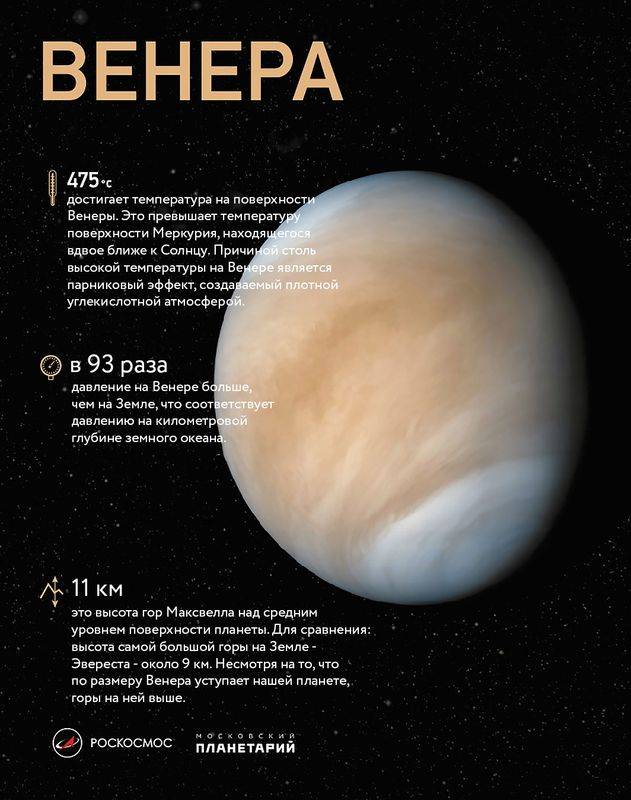
In the foreseeable future, only two planets in the solar system can be considered as possible objects of colonization: Venus and Mars. And taking into account the accumulated volume of knowledge on Venus, which was obtained, including thanks to the domestic astronautics, the obvious option remained only one - Mars. Venus, despite its similarity with the Earth in mass and size, proximity to our planet and a large surface area, since Venus has no oceans, the planet is very unfriendly. Venus receives two times more energy from the Sun than the Earth. On the one hand, this could be an advantage, allowing to solve many problems due to the energy of natural origin, but, on the other hand, this is the main problem. The advantages of Venus end quickly enough, but the shortcomings of the “morning star” are much larger, it is simply impossible for man to live and exist on the surface of Venus. The only option is to master the atmosphere of Venus, but to implement such a project in practice is very difficult.
For a person, the conditions of being on Venus are not just uncomfortable, they are intolerable. Since the temperature on the surface of the planet can reach 475 degrees Celsius, it is higher than the temperature on the surface of Mercury, located two times closer to the Sun than Venus. It is for this reason that the “morning star” is the hottest planet in our solar system. At the same time, temperature drops during the day are insignificant. Such a high temperature on the surface of the planet is due to the greenhouse effect, which is created by the atmosphere of Venus on 96,5 percent consisting of carbon dioxide. A person will not be happy with the pressure on the surface of the planet, which is 93 times the pressure on Earth. This corresponds to the pressure that is observed in the oceans on Earth when submerged to a depth of about one kilometer.
Soviet research program of Venus
The USSR began the study of Venus before the first flight of Yuri Gagarin into space. 12 February 1961 from the Baikonur cosmodrome to the second planet of the solar system went to the spacecraft Venus-1. The Soviet automatic interplanetary station flew in 100 thousands of kilometers from Venus, managing to reach its heliocentric orbit. True, the radio connection with the station "Venus-1" was lost earlier, when it retired from the Earth by about three million kilometers, the cause was a malfunction of equipment on board the station. From this case, lessons were learned, the information obtained was useful in the design of the following spacecraft. And the station Venus-1 itself became the first spacecraft to fly at close range from Venus.
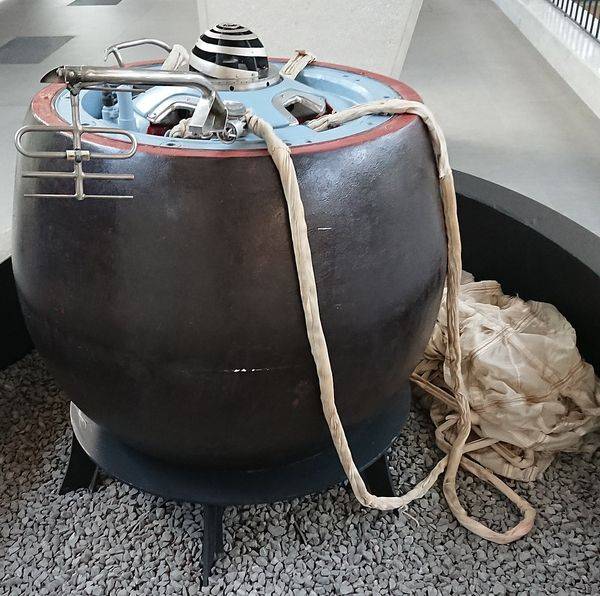
Over the next 20 and more, the Soviet Union sent dozens of spacecraft of various purposes to Venus, some of which successfully completed scientific missions in the vicinity and on the very surface of the planet. At the same time, the process of studying Venus by Soviet scientists was complicated by the fact that the researchers simply did not have data on pressure and temperature on the planet second from the Sun.
The launch of "Venus-1" was followed by a series of unsuccessful launches, which were interrupted by the launch of the Venus-3 automatic interplanetary station in November 1965, which was finally able to reach the surface of the second planet of the Solar System, becoming the first in the world stories a spacecraft that got to another planet. The station was unable to transmit data about Venus itself, even before landing on the AMC, the control system failed, but thanks to this launch, valuable information about space and near-planet space was obtained, and a large array of trajectory data was accumulated. The information obtained was useful for improving the quality of ultra-long-haul communications and future flights between the planets of the solar system.
The next Soviet space station, called Venus-4, allowed scientists to obtain the first data on the density, pressure and temperature of Venus, and then the whole world learned that the atmosphere of the "morning star" is more than 90 percent carbon dioxide. Another important event in the history of the study of Venus was the launch of the Soviet apparatus "Venus-7". 15 December 1970 was the first ever soft landing of a spacecraft on the surface of Venus. The Venus-7 station has forever entered the history of astronautics, as the first fully operational spacecraft, which successfully landed on another planet in the solar system. In 1975, the Soviet devices “Venus-9” and “Venus-10” allowed scientists to obtain the first panoramic images from the surface of the planet under study, and in 1982, the landing device of the station “Venera-13” assembled by the designers of the Lavochkin Scientific-Production Association, sent to the Earth the first ever color photographs of Venus from its landing site.
According to Roskosmos, just from 1961 to 1983 year, the Soviet Union sent automatic interplanetary stations to Venus 16, also in 1964, after the launch of the AMS "Venus-1", the uncontrolled passage of Venus "Zond-1" was made, and in 1984 the year was “ the morning star "went to two new Soviet apparatus, called" Vega-1 "and" Vega-2. "
"Flying Islands of Venus"
According to experts, the only option for the development of Venus by man is life in its atmosphere, and not on the surface. Back at the beginning of 1970, Soviet engineer Sergey Viktorovich Zhitomirskiy published an article titled “Flying Islands of Venus”. The article appeared in the 9 issue of Technique for Youth magazine for 1971 a year. A person can live on Venus, but only in the atmosphere at an altitude of about 50-60 kilometers using air balloons or airships. It is extremely difficult to implement this project, but the mechanism of development is clear. If a man managed to gain a foothold in the atmosphere of Venus, the next step would be to change it. Actually Venus is better than Mars by the fact that the atmosphere on the planet really exists, that it is not fit for life and colonization is another question. Theoretically, mankind could direct efforts to modify the atmosphere of Venus, using the accumulated knowledge and technology.
One of the first who proposed the idea of mastering and settling the clouds and the atmosphere of Venus was the scientist of the American space agency and science fiction writer Jeffrey Landis. He also noticed that the surface of the planet is too unfriendly for the colonists, and the pressure on the surface is simply monstrous and far from the pressure in one terrestrial atmosphere, while Venus is still a planet of the earth group, much like Earth and with almost the same acceleration free the fall. But for humans, Venus becomes friendly only at a height of more than 50 kilometers above the surface. At this altitude, a person is confronted with air pressure that is comparable to that of the earth and approaches the same atmosphere. At the same time, the atmosphere itself is still dense enough to protect potential colonists from harmful radiation, fulfilling the same protective screen role as the atmosphere of the Earth. At the same time, the temperature also becomes more comfortable, falling to 60 degrees Celsius, it is still hot, but humanity and the available technologies allow to cope with such a temperature. Moreover, if you rise several kilometers higher, the temperature will become even more comfortable, reaching 25-30 degrees, and the atmosphere itself will still protect people from radiation. Advantages of Venus also include the fact that the gravity of the planet is comparable to that of the earth, so the colonists could live in the clouds of Venus for years without any special consequences for their body: their muscles would not weaken, and the bones would not become fragile.
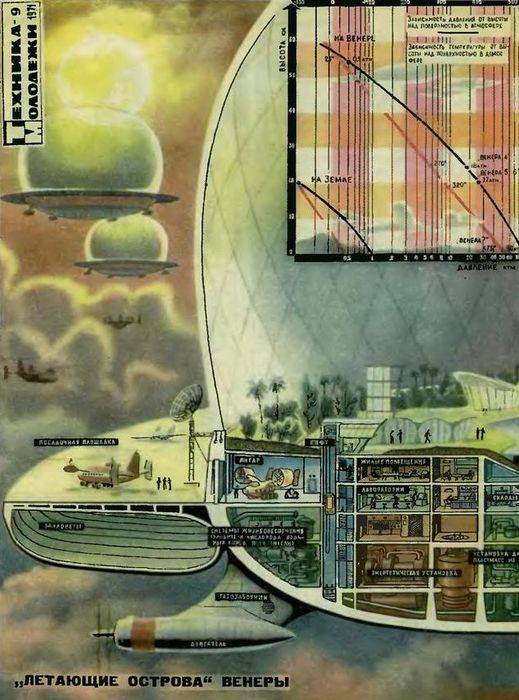
The Soviet engineer Sergey Zhitomirsky, who was hardly familiar with the point of view of his American colleague, also held about the same point of view. He also spoke about the possibility of deploying a permanent scientific base in the atmosphere of Venus at an altitude of more than 50 kilometers. According to his plans, this could be either a large balloon or, even better, a dirigible. The airship shell Zhytomyr proposed to be made of thin corrugated metal. According to his ideas, this would have made the shell tough enough, but left the ability to change the volume. In the atmosphere of the "morning star" the base was to cruise at a predetermined height along predetermined trajectories, moving above the surface of the planet and, if necessary, hovering in the sky above certain points of interest to researchers.
He thought a Soviet engineer and how to fill the shell of aircraft for the sky of Venus. According to his idea to carry helium, traditional for these purposes, from Earth, made no sense. Although the helium's own weight would be approximately 9 percent of the mass of balloons, cylinders in which it would be necessary to transport gas to the planet under the pressure of atmospheres 300-350, would be pulled as much as the entire aircraft would weigh. Therefore, Sergey Zhitomirskiy proposed to take ammonia from low-pressure cylinders or ordinary water from the Earth, which would help to significantly reduce the mass of cargo delivered. Already on Venus under the pressure of the high temperatures of the planet, these liquids themselves would turn into steam (without any energy consumption), which would serve as a working fluid for a balloon.
In any case, neither in the 1970-ies, nor now the program for the development of Venus is not a priority for the development of world space exploration. Colonization of other planets is a very expensive pleasure, especially when it comes to such an environment unfavorable to human life, which is today observed on the surface of the "morning star". So far, all the views of mankind are riveted to Mars, which, although it is further away and does not have its own atmosphere, still seems to be a much more friendly planet. Especially if we consider the option of building a scientific base on the Martian surface.
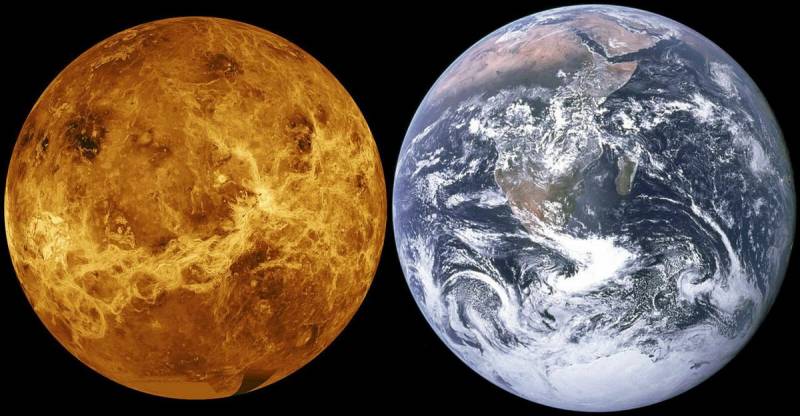
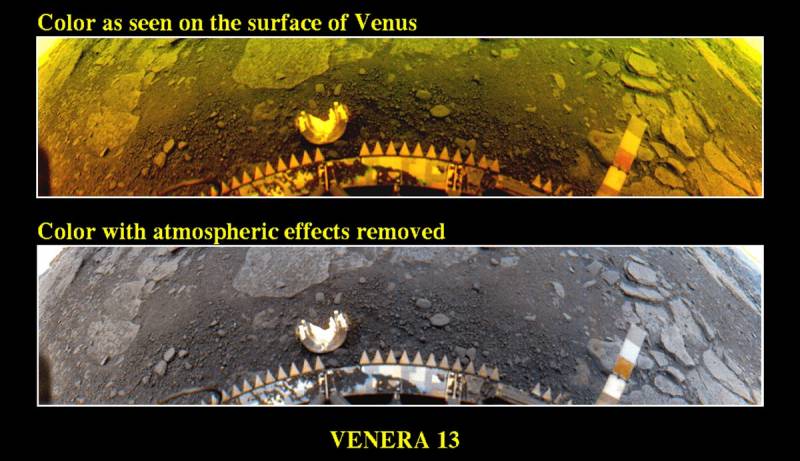
Information